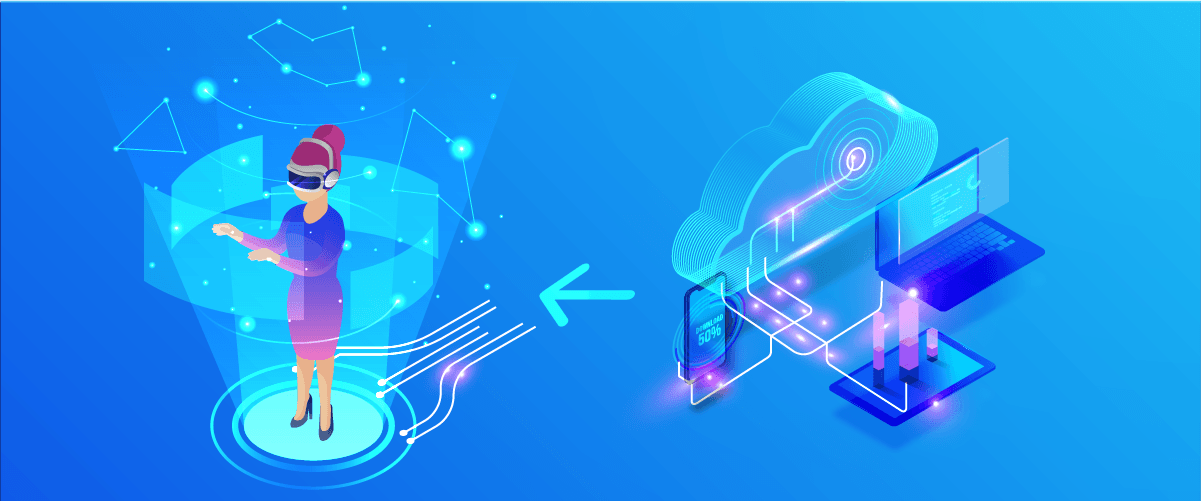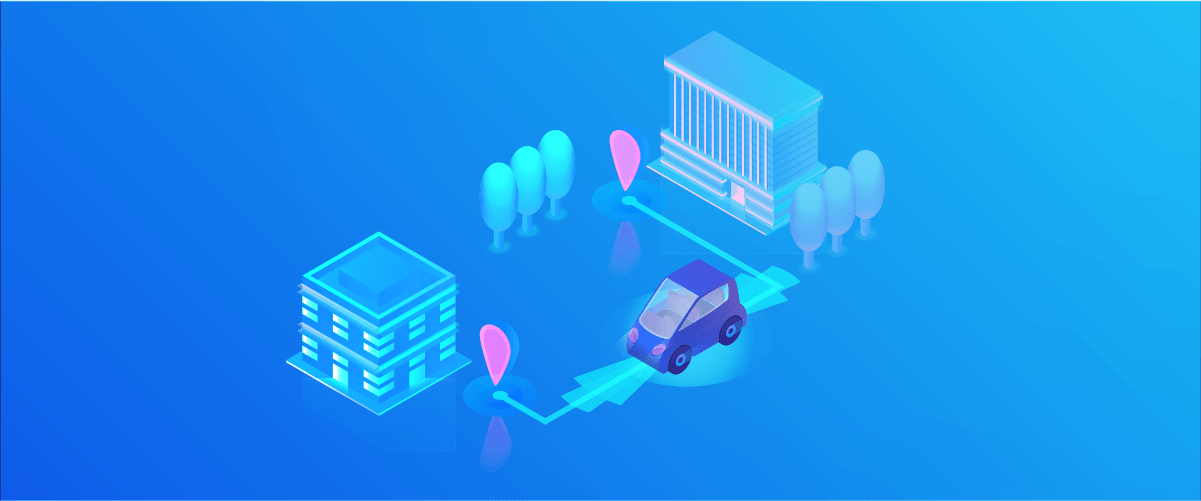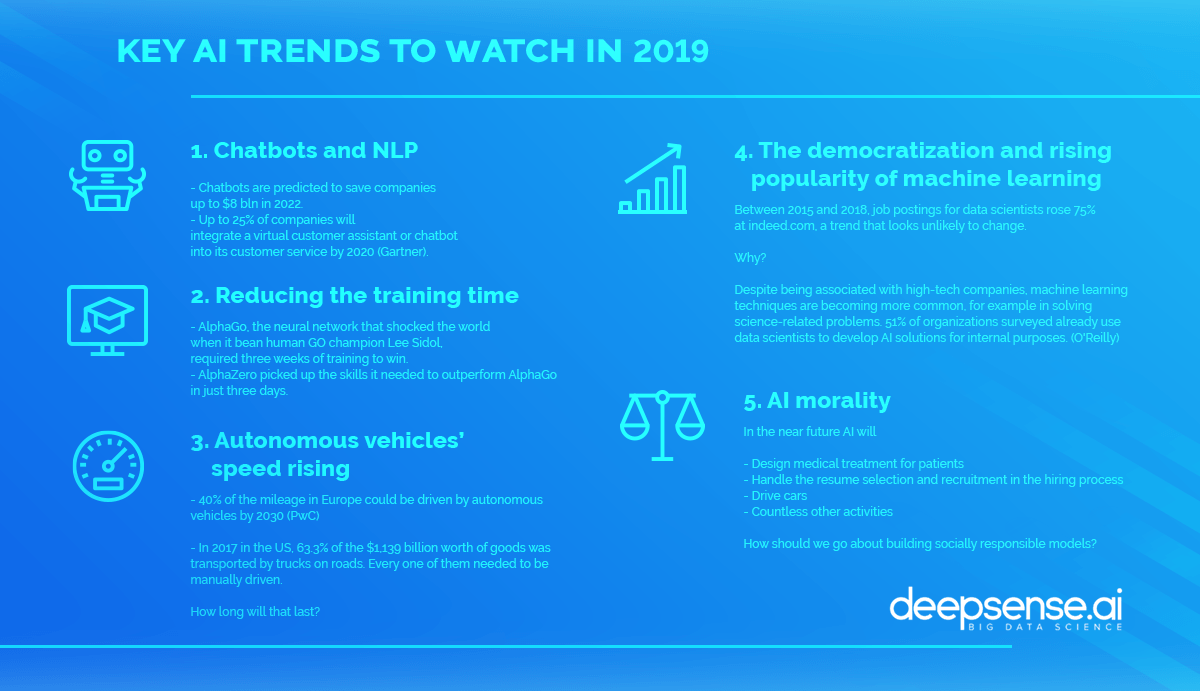Five top artificial intelligence (AI) trends for 2019
As the recently launched AI Monthly digest shows, significant improvements, breakthroughs and game-changers in machine learning and AI are months or even weeks away, not years. It is, therefore, worth the challenge to summarize and show the most significant AI trends that are likely to unfold in 2019, as machine learning technology becomes one of the most prominent driving forces in both business and society.
According to a recent Deloitte study, 82% of companies that have already invested in AI have gained a financial return on their investment. For companies among all industries, the median return on investment from cognitive technologies is 17%.
AI is transforming daily life and business operations in a way seen during previous industrial revolutions. Current products are being enhanced (according to 44% of respondents), internal (42%) and external (31%) operations are being optimized and better business decisions are being made (35%).
With that in mind, it is better to see the “Trend” as a larger and more significant development than a particular technology or advancement. That’s why chatbots or autonomous cars are not so much seen as particular trends, but rather as separate threads in the fabric that is AI.
That distinction aside, here are five of the most significant and inspiring artificial intelligence trends to watch in 2019.
1. Chatbots and virtual assistants ride the lightning

The ability to process natural language is widely considered a hallmark of intelligence. In 1950, Alan Turing proposed his famous test to determine if a particular computer is intelligent by asking the ordinary user to determine if his conversational partner is a human or a machine.
The famous test was initially passed in 1966 by ELIZA software, though it had nothing to do with natural language processing (NLP) – it was just a smart script that seemed to understand text. Today’s NLP and speech recognition solutions are polished enough not only to simulate understanding but also to produce usable information and deliver business value.
While still far from perfect, NLP has gained a reputation among businesses embracing chatbots. PwC states that customers prefer to talk with companies face-to-face but chatbots are their second preferred channel, slightly outperforming email. With their 24/7 availability, chatbots are perfect for emergency response (46% of responses in the PwC case study), forwarding conversations to the proper employee (40%) and placing simple orders (33%). Juniper Research predicts that chatbots will save companies up to $8bln annually by 2022.
NLP is also used in another hot tech trend–virtual assistants. According to Deloitte, 64% of smartphone owners say they use their virtual assistant (Apple Siri, Google’s Assistant) compared to 53% in 2017.
Finally, Gartner has found that up to 25% of companies will have integrated a virtual customer assistant or a chatbot into their customer service by 2020. That’s up from less than 2% in 2017.
2. Reducing the time needed for training

Academic work on AI often focuses on reducing the time and computing power required to train a model effectively, with the goal of making the technology more affordable and usable in daily work. The technology of artificial neural networks has been around for a while (theoretical models were designed in 1943), but it works only when there are enough cores to compute machine learning models. One way to ensure such cores are present is to design more powerful hardware, though this comes with limitations. Another approach is to design new models and improve existing ones to be less computing hungry.
AlphaGo, the neural network that vanquished human GO champion Lee Sidol, required 176 GPUs to be trained. AlphaZero, the next iteration of the neural network GO phenom, gained skills that had it outperforming AlphaGo in just three days using 4 TPUs.
Expert augmented learning is one of most interesting ways to reduce the effort required to build reinforcement-based models or at least ones that are reinforcement learning-enhanced. Contrary to policy-blending, expert augmented learning allows data scientists to channel their knowledge not only from another neural network but also from a human expert or another machine. Researchers at deepsense.ai have recently published a paper on using transfer learning to break Montezuma’s Revenge, a game that reinforcement learning agents had long struggled to break.
Another way to reduce the time needed to train a model is to optimize the hardware infrastructure required. Google Cloud Platform has offered a cloud-based tailored environment for building machine learning models without the need for investing in on-prem infrastructure. Graphics card manufacturer Nvidia is also pushing the boundaries, as GPUs tend to be far more effective in machine learning than CPUs.
Yet another route is to scale and redesign the architecture of neural networks to use existing resources in the most effective way possible. With its recently developed GPipe infrastructure, Google has been able to significantly boost the performance of Generative Adversarial Networks on an existing infrastructure. By using GPipe, researchers were able to improve the performance of ImageNet Top-1 Accuracy (84.3% vs 83.5%) and Top-5 Accuracy (97.0% vs 96.5%), making the solution the new state-of-the-art.
3. Autonomous vehicles’ speed rising

According to PwC estimates, 40% of mileage in Europe could be covered by autonomous vehicles by 2030. Currently, most companies are still developing the technology behind these machines. We are proud to say that deepsense.ai is contributing to the push. The process is driven mostly by the big social and economic benefits involved in automating as many driving processes as possible.
According to the US Department of Transportation, 63.3% of the $1,139 billion of goods shipped in 2017 were moved on roads. Had autonomous vehicles been enlisted to do the hauling, the transport could have been organized more efficiently, and the need for human effort vastly diminished. Machines can drive for hours without losing concentration. Road freight is globally the largest producer of emissions and consumes more than 70% of all energy used for freight. Every optimization made to fuel usage and routes will improve both energy and time management.
The good news here is that there are already advanced tests of the technology. Volvo has recently introduced Vera, the driverless track aimed at short-haul transportation in logistics centers and ports. Its fleet of cars is able to provide a constant logistics stream of goods with little human involvement.
In a related bid, US grocery giant Kroger recently started tests of unmanned delivery cabs, sans steering wheel and seats, for daily shopping. Bolder still are those companies (including Uber) testing their autonomous vehicles on the roads of real towns, while others build models running in sophisticated simulators.
With Kroger, Uber and Google leading the way, other companies are sure to fall into line behind them, forming one of most important AI trends 2019.
4. Machine learning and artificial intelligence will be democratized and productionized

There would be no machine learning without data scientists, of which there remain precious few, at least of the skilled variety. Job postings for data scientists rose 75% between 2015 and 2018 at indeed.com while job searches for this position rose 65%. According to Glassdoor data, data scientist was the hottest job in 2018. Due to the popularization of big data, artificial intelligence and machine learning, the demand for data science professionals will continue to rise. And that not only enterprise but also scientific researchers seek their skills certainly bodes well for the profession.
Despite being associated with high-tech companies, machine learning techniques are becoming more common in solving science-related problems. In the last quarter of 2018, Deepmind unveiled a tool to predict the way proteins fold. Another project enabled scientists to derive the laws of physics from fictional universes.
According to O’Reilly data, 51% of surveyed organizations already use data science teams to develop AI solutions for internal purposes. The adoption of AI tools will no doubt be one of the most important AI trends in 2019, especially as business and tech giants are not the only organizations using AI in their daily work.
5. AI responsibility and transparency

Last but not least, as the impact of machine learning on business grows, so too does the social and legal impact. On the heels of the first fatal accident involving an autonomous car, the question of who is responsible for crashes and the famous trolley problem are getting more important.
At issue here, first and foremost, is hidden bias in data sets, a problem for any company using AI to power-up daily operations. That includes Amazon, which had put AI in charge of preprocessing resumes. Trained with 10 years worth of various resumes, the system was unintentionally biased against women applying for tech positions. With the rising adoption of machine learning models in various industries, the transparency of artificial intelligence will be on the rise. The issue of countering bias unconsciously developed within datasets and taken by machine learning models as truth incarnate is being discussed seriously by tech giants like Salesforce. The machine learning community has also taken up the problem: there is a Kaggle competition aimed at building unbiased and cultural context-agnostic image recognition models to use in computer vision.
Finally, as I alluded earlier, the question of who is responsible for actions taken by AI-powered devices and the famous trolley problem are both moving to the fore. If a self-driving car had a choice, should it hit an elderly person or a child? Focus on saving the life of a driver or a person walking by? According to a global study, the answers depend heavily on the culture the responder grew up in. When facing the extreme situation of a car accident today, it is the driver who is solely responsible for his or her choices. When the car is autonomous, however, and controlled by a virtual agent, all the choices are made by a neural network, which raises some very unsettling questions.
Of course, such problems are not confined to the realm of autonomous vehicles. Machine learning-powered applications are getting more and more attention as a tool for supporting medical treatment. Medical data is expected to rise at an exponential rate, with a compound annual growth rate of 36%. Considering the high level of standardization within diagnostic data, medical data is ripe for utilizing machine learning models, which can be employed to augment and support the treatment process.
When thinking about AI trends 2019, bank on more transparent and socially responsible models being built.
The take-away – the social context will be central to AI trends 2019
No longer are AI and machine learning confined to pure tech; they now have an impact on entire businesses and the whole of society. The common comparison with the steam engine revolution is an apt one – machine learning models will digitally transform both big and small business in ways never before seen.

Given that, picking AI trends 2019 only by selecting technology would be to miss a vital aspect of ongoing changes. That is, they are as ubiquitous as they are far-reaching.



